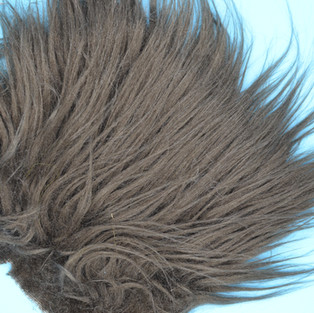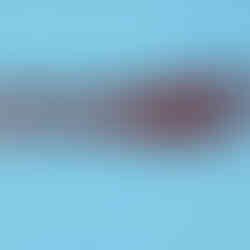Part 1 - Project Clouser: Materials
- Jason G. Freund
- Aug 28, 2020
- 8 min read
Updated: Mar 11, 2023
While the original Clouser Deep Minnow is a bucktail fly, there are tons of other materials - natural and synthetic that can tie a Clouser fly with. In general, there is a trade off between stiffness of fibers and movement. Bucktail is a pretty good mix of the two characteristics. Fibers that are too soft (i.e. marabou, some synthetics) will move a lot which looks enticing but they will also foul your hook and in the case of some synthetics, they'll make one hell of a tangle.

This post will mostly be about the "wing" or belly and back materials and how to incorporate flash into your Clouser Deep Minnows. I'll get into different weighting options in another Project Clouser post. There are tons of variations on the Clouser Deep Minnow and Mr. Clouser has published a number of patterns to represent different forage fishes. If you - like me - are not a big follow the recipe person, the general pattern is light belly, maybe a lateral line color, and a darker top. That countershading pattern - light on the bottom dark on the top - ranges from the smallest of minnows to Great White Sharks and penguins, whales, etc. And of course, remember that the dumbbell eyes flip the hook point up so the top of the hook shank becomes the belly.
The Clouser Deep Minnow (Silver Shiner)
Hook: Size 2 Mustad 71S SS (For more on the hook)
Thread: Uni 6/0 Gray
Eyes: 1/30 ounce metallic dumbbell eyes
Belly: White deer-tail fibers
Middle: Rainbow Krystal Flash
Back: Gray deer-tail fibers
That is the general pattern. It changes for different forage fishes but the idea remains pretty consistent. Look for the minnows or other forage fishes (i.e. sculpin, small suckers) that you expect to see in your waters and try to mimic them. Or just use some white for the belly and find a way to use some chartreuse in the middle and/or back. Lastly, on the hook, there are tons of options. I've never used the circle streamer hook called for in the recipe but I do often tie them on stainless steel hooks. The Mustad 34007 or an equivalent is a standard choice. But any moderately long - but not too long - shank will work. Many like tying them on 60 degree jig hooks.
Bucktail
First, "bucktail" does not necessarily come from a buck, it is a White-tailed Deer tail. That, I assume, is why Mr. Clouser, calls for "deer-tail fibers. If you're looking in your local fly shop or online, you'll find it labeled as bucktail.
Bucktail is high on my list of favorite materials for streamers. In the right parts of the tail, it is a nice mix of stiffness and movement. It is great for tails on a number of streamers as it will help hold up flash and other softer materials and keep them from from fouling the hook.

White bucktail is almost certainly going to be the color you use the most so look for good quality bucktail. If you are mostly going to be tying Clouser minnows, look for bucktails with fibers that are straight and long enough for the flies you'll be tying. While bucktails are generally relatively inexpensive, you will pay more for bucktails with longer fibers. If you are not tying flies longer than 3-4 inches, quality bucktails will typically cost you $6 - $8 and a bit more if you buy unique dye colors, tip dyed tails, or UV treated. I really like some of the colors listed as pastels as they seem to be more natural looking. Typically the larger - and better - tails will be listed as "northern" which just means that deer in the north tend to be larger. If you need really long fibers, your best bet are shops that specialize in musky or saltwater flytying.
These shots of a yellow chartreuse bucktail (click on images to enlarge). The first photo shows the butt end of the bucktail which is typically too hollow and will flair a little more than you probably want in a Clouser. Photo 2, the tip of the bucktail, will be the least hollow and generally the stiffest so it will not flare nor move much in the water. It is my choice for tails on a number of streamers like the Murdoch Minnow, a personal favorite. And photo 3 is the sweet spot of the bucktail. The fibers here will flare only a little and are the perfect material for Clouser minnows. As you look at the different parts of a tail, you'll notice that as you move from the tip to the base, there is more "krinkle". This waviness in the hair is an indication of how hollow the fibers are. Fibers that are hollow will compress more - like bass bug hair does. Less compressible fiber - like those at the tip of a bucktail, calf tail, and squirrel are generally "slippery" and create less bulk for the same number of fibers used. For a Clouser minnow, you are looking for light to medium "krinkle" that will provide a little bulk but not too much.
Brian Wise, Fly Fishing the Ozarks, provides a good commentary about what to look for in bucktail for different types of purposes.
Below is an example of a really spectacular bucktail. First of all, it is large. Not only does it have long fibers, it is long and has a long sweet spot. The tips of the fibers are unbroken and the fibers themselves have a little "krinkle" to them but not too much.


If you tie a bunch of different patterns, you can find ways to pretty much use the entire bucktail. If you are tying mostly Clousers, you might have a lot bucktails with just the tips and butts remaining. If you don't have uses for all of the tail, your musky fishing friends may find them useful. The Mangrove Muddler is a saltwater pattern I was taught by an experienced tyer that is an effective trout and bass fly and uses up bucktails if you are feeling particularly frugal.

Good bucktails are not that hard to find but you can get some real duds. If you know what you are looking for in the fly shop, you will do fine. Online, it is a bit more hit or miss but buy from reputable shop, they will be willing to help and *should* be stocking good materials. Here is a list of Wisconsin fly shops: https://wiflyfisher.com/Wisconsin-Fly-Fishing-Shops.asp
Other Natural Materials
There are a ton of different natural materials that work in place of bucktail like many of the different foxes. Arctic fox is a great material that is quite soft. Smaller Clousers and some of the other Clouser patterns utilize calf (kip) tail. And marabou will make a Clouser that moves with the slightest current or rod / line movement. The general problem with softer materials is that they can foul on the hook. You might want to use a bucktail underwing and the hi-tie style where all the materials are placed so they are above the eyes.

There are tons of options. The greatest limitation is your imagination. I won't get into all the options because I can't cover it all here. Try out some different things and see how they work for you.
Synthetics
Like the natural options for materials other than bucktail, there are a ton synthetic options. I would say that I tie at least 80% of my Clousers with bucktail but synthetics provide some great options. Craft fur (the first three images below) is a great option and today there are some really nice craft furs with longer fibers and flash incorporated. Nightmare Musky Flies has some great options. There are tons of other options (I included labels, when I had them) that are all a little different. They range from quite soft to much stiffer materials. They even make a synthetic bucktail (Faux bucktail) but I have not tried it.
Flash
Let's start this the same way as the other sections - there are a ton of flash options. It really is the golden age for fly tying materials with more and more cool stuff coming out all the time. Krystal flash (image 4) and flashabou (most of the other are versions of flashabou) are the standards for adding flash to Clousers but today, there are a ton more options. One of may favorite materials for streamers is Ripple Ice Fiber which comes in a few different types. Some is translucent (image 1) and some are more pearlescent (images 2 and 3). To me, it has properties somewhat similar to bucktail but without the natural taper of bucktail.
I will say in synthetics and flash, there are a number of cheaper alternatives in the synthetic world. Let's face it, most of these materials are not developed for us, the fly tyer. As such, in many cases, you can buy essentially the same thing as the "name brand" from other providers (even craft shops). One of my favorite sources is the Fly Tyers Dungeon.
Other Possibilities
The possibilities are nearly limitless. I've seen Clousers with feathers for lateral lines, tied with only craft store materials or teased out yarn fibers, or any number of other materials. I see little reason to stray too far from the standard bucktail.
Comparison of Natural and Synthetic Materials
Both have their pros and cons but in general, I like bucktail for Clouser Deep Minnows of about 2 to 6 inches in length. Three to four-and-a-half inches is the typical length of a Clouser I tie. Bucktail is relatively durable, has some movement but will not foul a hook. Most of all, it is incredibly versatile. You can create flies with a little more bulk or really slender flies depending upon what part of the tail you use and how you tie down the bucktail.


The two images above give a pretty good idea of the versatility of bucktail. The top fly is a little bulkier which is accomplished by using more material as well as using bucktail fibers from closer to the base of the bucktail. The bottom fly uses a pretty cool blending technique. Here I wanted yellow and blue in the back of the fly but did not want them to be separate bands. Cut some fibers of each color, put them in a large hair stacker and give them a spin to mix them together. It can also be accomplished by using your fingers and mixing the fibers.

Obviously, the choice of synthetics will have a large affect on what the fly looks like - how much bulk, transparency, flash, and other characteristics. My personal choice is for more transparency / translucence and usually less flash. The Congo Hair Clouser (bottom left) will fit what I'm looking for more than the craft fur Clouser above it. However, if I want a fly that is going to make a very solid profile - like in fishing stained waters - craft fur might be a better choice.
The great thing about tying your own is that you can tie them just how you like. More flash. Less flash. Colors you can't find in fly shops. Really sparse and translucent Clousers. And sizes and profiles you won't find in stores. Maybe it matters, maybe it doesn't. But it makes it all a lot more fun and interesting.
Next week, different ways to tie the Clouser Deep Minnow.
Project Clouser Blog Entries
Introduction to Project Clouser (last week)























































I've only tied with bucktail.
I want to try Artic Fox.
I like to tie with natural materials and non-toxic metals, as much as possible.